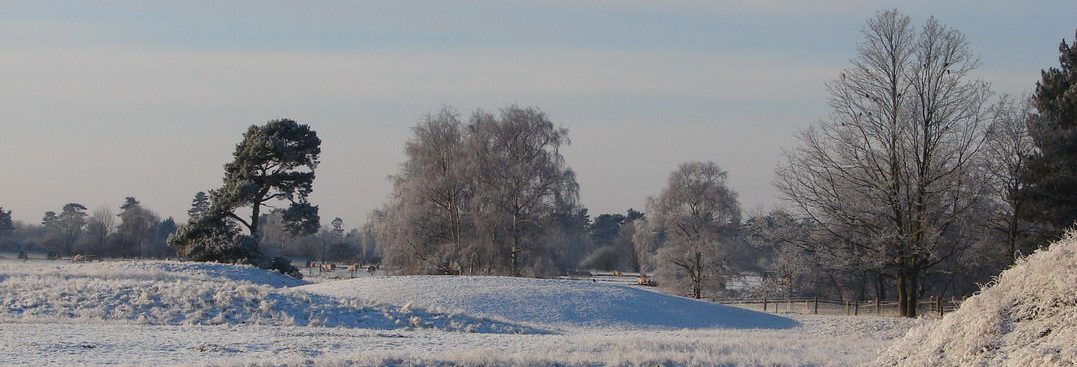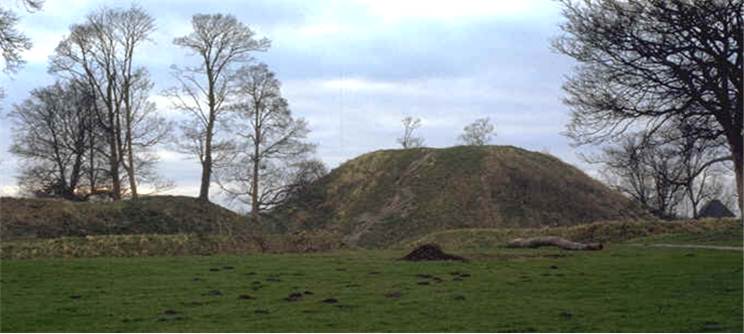Thetford was one of East Anglia’s major towns in the later Anglo-Saxon period and became the seat of the region’s bishops after their move from North Elmham in 1075 until Norwich Cathedral was built in the 1090’s. Today, the most prominent surviving feature of the old Thetford is the immense Norman motte of Castle Hill, which, at 81 feet high, is one of the largest man-made mounds in the country. It was probably built soon after 1066 and remained a baronial stronghold until it was confiscated by King Henry II in 1157, who had its defences dismantled after the war of 1173.
The great motte stands in the angle of a bailey with unusually large double ramparts surviving to the north and east. Excavations have suggested that it is unlikely that these continued round into the flood-plain to the south, where the Rivers Thet and Little Ouse run. Indeed, the bailey appears to have been formed from the earthworks of an Iron Age promontory-fortress which ran in a curve to the north of the rivers, with the latter forming its southern defences.
A view of Thetford Castle from the north-east showing the great Norman motte with the double rampart of the former Iron Age promontory fort incorporated into the defences of the bailey (author’s photograph)
This Iron Age fortress appears to have been built to control the fords which carry the ancient Icknield Way over the Little Ouse valley at this point. Indeed, these crossings appear to have given Thetford its name – from the Old English Theod-ford, ‘people’s ford’.
Before the Norman re-used these earthworks, they may have provided the defences of the winter base for the ‘great army’ of Danes which occupied Thetford in the autumn of 869, to which the Anglo-Saxon Chronicle refers. Its shape would be similar to the ship-fortress they built beside the River Trent at Repton in 874. It was this great army of Danes, led by the Ragnarrssons, which, while based at Thetford, defeated and killed one of the last and most famous of the later Wuffing kings of East Anglia, St Edmund, on 20th November 869.
Thetford was also a target for later Danish invasions. According to the Anglo-Saxon Chronicle, the town was attacked and burnt by Sweyn Forkbeard in 1004 as part of his campaign of retribution following the massacres of Danes on St Brice’s Day in November, 1002. As he was returning to his fleet at Norwich, Sweyn was met by the East Anglian Ealdorman Ulfcytel and his army on Wretham Heath to the north of the town. A hard battle followed and, although he could not prevent the Danes from getting back their ships, Ulfcytel earned the greatest respect from his opponents for his actions that day, as the Anglo-Saxon Chronicle tells us:
Swa hi sylfe sæðon, þæt hi næfre wyrsan hand plegan on Angelcynne ne gemitton þonne Ulfcytel him to brohte.
As they themselves [the Danes] said, that they never met with worse hand-play [i.e. battle-skill] among the English than Ulfcytel brought to them.
Ulfcytel thus came to be nicknamed Snillingr [perhaps ‘Valiant’] in Scandinavian sources and East Anglia came to be known as ‘Ulfcytel’s Land’. Ulfcytel fought another great battle against the Danes near Thetford on 5thMay, 1010. This was the famous Battle of Ringmere, which is described in the Anglo-Saxon Chronicle and in Old Norse saga. This battle appears to have taken place to the south of the town, with the Danes advancing from Ipswich under the leadership of Sweyn’s ally, Thorkell the Tall. The site was probably at the former meeting place now called Rymer Point. Ulfcytel eventually fell fighting against his old enemies the Danes at the Battle of Assendun in 1016, probably Ashdon near Hadstock in north-west Essex.
Unknown to the English, the Danes, and the Normans, a treasure-hoard lay buried on Gallow’s Hill to the north of the town near a Romano-Celtic altar site. It was here that in 1979 the Thetford Treasure was discovered by a free-lance metal detectorist. This very rich hoard dates from the second half of the fourth century and includes gold and silver bracelets, necklaces, pendants, and rings, many of which are bejewelled with precious stones. Also found were 33 silver spoons, many of which bear inscriptions to the woodland fertility god Faunus.
Just to the north of the buried tresure, also on Gallow’s Hill, was an important Late Iron Age Iceni religious site. The outline crop-markings of this great rectangular sanctuary were discovered by chance from the air by archaeologist Bob Carr in 1980. Excavations in 1981 showed that during the time of the famous Iceni queen Boudicca, it was enclosed by ditches, banks, and up to nine rows of closely spaced oak uprights, perhaps with branches still on them. This created what one archaeologist described as ‘an artificial oak grove’ (for more on this fascinating site, see Tony Gregory, Excavations in Thetford, 1980-1982, Fison Way, Vol.1, East Anglian Archaeology Report No.53 [Norfolk Museums Service 1991]).
© Copyright Dr Sam Newton, Blotmonaþ AD 2000


